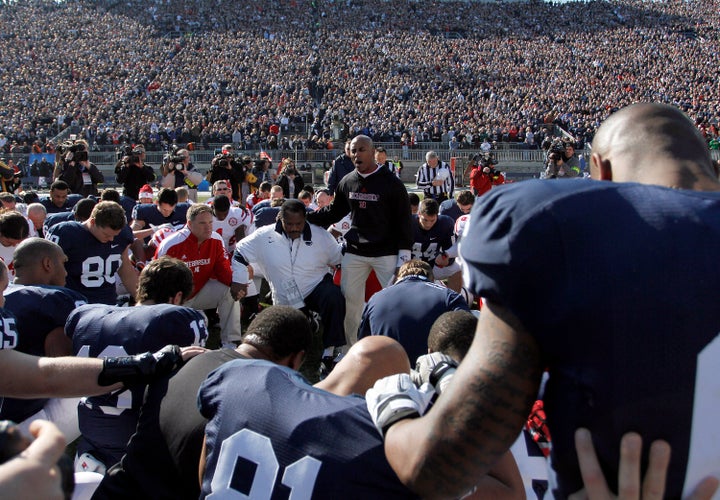
Watching coaches and players from Nebraska and Penn State kneel for a pre-game prayer in Beaver Stadium a week ago, I had to admire the sentiment if not the practice. Given recent events that have rocked the campus at State College, I, along with many (including apparently, Bo Pelini the Nebraska coach), felt the game should have been canceled. But having decided to play it, pausing before the game to recognize the tragedies that had been inflicted on young boys was probably a good idea. I'm just not sure that prayer should have been the ritual.
Nebraska assistant coach Ron Brown's prayer was offered before an assembly of kneeling players and coaches from both sides. Whether or not the 100,000+ fans in attendance were meant to be joint supplicants or simply observers wasn't explained ,although, given that the prayer wasn't broadcast over the stadium's public address system and that fans' chants drowned out the last few moments of Brown's supplication, that latter was most likely. Regardless of fans' inattentiveness the organizers of the prayer clearly intended for the audience (both present and televised) to the prayer. Why else arrange for it to be on the 50-yard line?
The prayer rambled, mixing adoration with petition along with some old coach's rhetoric that appeared to be designed to help hulking young men make the transition from tranquil piety to not so tranquil battle. "We give you glory that your going to protect this stadium and town today," prayed Brown. "You know there are a lot of little boys out there who are trying to figure out what the definition of manhood is all about. Father this is it right here. I pray that this game will be a training round for what manhood looks like and that we may compete with the fierce intensity with honor and gifts and talents that you've given us."
Asked about the purpose of the prayer, Brown, who apparently consulted with the evangelically oriented Fellowship of Christian Athletes and Athletes in Action, gave a somewhat convoluted theological explanation: "It was a reminder that God chose this time and it was beyond anyone else's control ... but what we could control was our attitude and spirit, and what we could remind America was there were a lot of little boys around this country who are watching this game, trying to make sense of life." If it was a bit confusing, it is par for the course; a brief mention of the tragedies that had surfaced, but on the whole a slight variation on the typical athletic prayer.
Pausing in the stadium in the midst of the Saturday afternoon festivities to remember the victims of Sandusky's alleged abuses made a great deal of sense, if only because the offenses were perpetrated in the environs of stadiums and locker rooms. But why a prayer spectacle was required to do this isn't at all clear to me. Wouldn't a few carefully chosen words spoken by the coaches over the stadium public address system -- assuring the victims that they were not forgotten in the decision to play the game, and that everybody in the stadium stood shoulder to shoulder with them in seeing that justice gets done -- have been a more fitting gesture?
And if a prayer was to be offered, why in front of 100,000+ fans? Surely the mammoth locker rooms and team meeting rooms at Penn State could have accommodated all the players and coaches; why not arrange for a prayer in "the closet" away from the rowdiness of the stadium? Why weave the most sacred act of humanity into a secular spectacle laden with sentiments and symbols that too often run hard against the Christian grain? Why pray in an atmosphere that was unsympathetic to prayer? Why pray when the fans try to shout out the prayer?
In this case, the answer seems to have been that -- like Denver Bronco Tim Tebow's genuflection in the end zone or the NFL's post-game prayer circle -- the prayer was intended, first and foremost, to call attention to itself. Like staged invocations by civil rights leaders and right wing zealots camped on the front steps of the Supreme Court, the prayer was a calculated demonstration, meant more to convey a mood or signal a sentiment, than to converse with God. Regrettably, like most on-field prayers and religious gestures by athletes, they too easily become part of the spectacle itself, glitzy, shallow and inevitably ostentatious, cheapening the meaning of prayer in the process.
Were he alive today, the martyred theological giant Dietrich Bonhoeffer's could help point the athletic community in the right direction. Bonhoeffer knew that prayer -- even when done in private -- carries the risk that the supplicant will become "the one who at the same time prays and looks on." For Bonhoeffer prayer should be "the supreme instance of the hidden Christian life," and for this reason, "it is never given to self-display, whether before God, ourselves or other people." In saying this, he was merely echoing the One who taught us to pray.